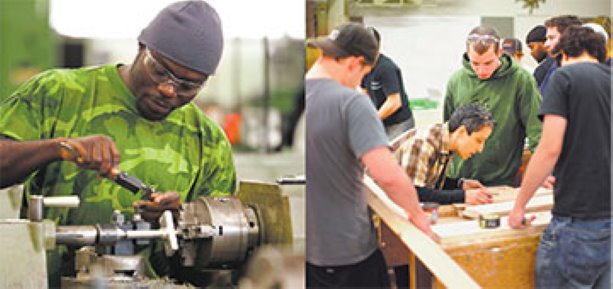In many cases, a person committed to the idea of a construction career faces an additional hurdle — the choice of a specific trade. A George Brown College program has been aiming to help construction students make informed choices by exposing them to a broad range of trades over a single year.
The Construction Trades Techniques Program, launched in 2009, takes students on a one-year tour of eight trades. In the first semester, students take plumbing, welding and steamfitting. In the second, they’re introduced to electrical and millwrighting. In the final semester, they experience carpentry, sheet metal and air conditioning.
“The program was created simply because students have no way to discover what they like and don’t like about various trades in the construction industry,” says Geurt Van De Kraats, chair, Skilled Trades & Apprenticeship with George Brown. “In some cases students only have a residential construction model in mind when they sign up. Once they experience the various trades, they understand the importance of each trade to residential, industrial and commercial construction and have a strong idea for which trade they have the greatest aptitude.”
Students also take general education courses and learn from a combination of instructor-led sessions, guest lectures and site visits. The program covers additional topics, such as networking, apprenticeship and the differences between union and non-union shops.
Van De Kraats says students are divided into three roughly equal demographic segments. One third enters the program directly from high school, and another third arrives from a different post-secondary education program.
“Another third is composed of students who have already joined the workforce and are working either part-time or in a job they don’t find very rewarding and are coming back to get some targeted training,” notes Van De Kraats.
About 150 students are enrolled in the program on an ongoing basis, with 75 entering the program in September, 50 in December and 25 in May. In August, 75 students will graduate and be replaced by the new fall entries.
While some students simply graduate with a broad range of construction trade skills, others realize when they’ve experienced their “aha” moment.
“I recently asked a student about his experience with the program,” says Van De Kraats. “He told me that when he entered the plumbing semester he told himself, ‘This is what I want do — I’m finally home.’”
Graduates are hired directly from the program, enter apprenticeship programs, or go on to more targeted education programs, such as George Brown’s Plumbing Techniques, Electrical Techniques or HVAC program.
The success of the program, however, has created a double-edged sword. Some students are so enthusiastic about finding their trade of choice that they leave the program after completing the current semester.
“In some cases they tell me that they’ve already found contacts and arranged their own placement and that they’re heading out to begin an electrical apprenticeship the following Monday,” says Van De Kraats.
“That’s a successful placement, but we have a bit of concern that anyone looking at the student statistics will see that person as someone who has quit the program. Leaving the program is fine with me, as long as I know they’re leaving for the right reason.”
In other cases, employers offer students a job prior to graduating, often working with program staff to incorporate work experience into the remainder of the program.
Van De Kraats made his choice of trade more than 40 years ago, beginning work as an electrician in 1966. However, he doesn’t regret his decision to join the staff of George Brown in 1978.
“I’m particularly happy with this program, which was developed by a broad range of talented people at the college,” he says. “It’s something I’ll be proud to look back on when I retire.”



Recent Comments
comments for this post are closed